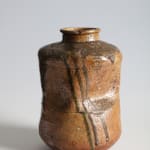-
Artworks
Shigaraki Jar for Tea Leaves, 16th/17th century
Stoneware with natural ash glazeSize 12¼ x 8¾ x 8½ in. (31 x 22 x 21.5 cm)T-4719Further images
-
(View a larger image of thumbnail 1
)

-
(View a larger image of thumbnail 2
)

-
(View a larger image of thumbnail 3
)

-
(View a larger image of thumbnail 4
)

-
(View a larger image of thumbnail 5
)

-
(View a larger image of thumbnail 6
)

-
(View a larger image of thumbnail 7
)

-
(View a larger image of thumbnail 8
)

-
(View a larger image of thumbnail 9
)

-
(View a larger image of thumbnail 10
)

-
(View a larger image of thumbnail 11
)

-
(View a larger image of thumbnail 12
)

-
(View a larger image of thumbnail 13
)

The roughly cylindrical form with waisted sides, broad shoulder, vertical mouth, rounded everted rim, and slightly depressed base, the stoneware body with many feldspathic inclusions, mostly covered in a green...The roughly cylindrical form with waisted sides, broad shoulder, vertical mouth, rounded everted rim, and slightly depressed base, the stoneware body with many feldspathic inclusions, mostly covered in a green ash glaze that reaches down to the base in several places, one side with three striking parallel lines of dripping glaze, the mouth with a small kintsugi (gold lacquer repair)
Comes with a fitted paulownia-wood storage box, the lid inscribed: Shigaraki Katatsuki senbeitsubo Iga-kei (Shigaraki “rice-cracker” container for tea leaves in Iga style)
It is thought that containers of this type were traditionally called senbei (rice-cracker) jars from the character of the fired clay from which they are made, with the slightly “puffed-out” appearance of baked glutinous rice. The rich glaze, formed from flying ash that fell on this classic tea-ceremony piece during the long firing process, has given it an excellent keshiki (surface “landscape”) that admirably complements its elegant form.
-
(View a larger image of thumbnail 1
)












